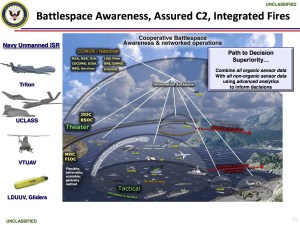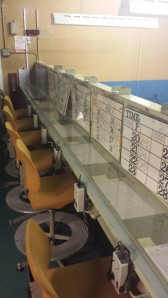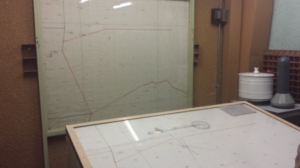Kevin Grove’s engaging photo-essay about community disaster plans from his fieldwork in Trinityville, Jamaica, available from the Society and Space open site.
Resilience: what becomes of politics in an era of uncertainty
Jonathan Pugh, Newcastle University, talking about his paper in Area on uncertainty and what it means for governing everyday life.
“But resilience does not seek to control the world in the way of previous scientific and political models. Instead, resilience more obviously foregrounds how vulnerability and insecurity are inevitable parts of life. Risks, hazards and dangers are accentuated as permanent features of everyday existence; always there, always at the surface to be highlighted and engaged. Precarity bears down upon the present and resilience politics actively embraces it.”
By Jonathan Pugh, Newcastle University
 Flood on Protocol Street, Jakarta Image. Credit: Flicker user mulya reproduced under 74 CC-BY-NC-ND
Flood on Protocol Street, Jakarta Image. Credit: Flicker user mulya reproduced under 74 CC-BY-NC-ND
The word ‘resilience’ seems to capture something about life in our precarious and uncertain era. The idea that we should all learn to be more resilient and adaptable, able to rapidly adjust to crises and the complexities of modern life as they happen, says something about the mood of our times. Indeed, Time Magazine recently proclaimed ‘resilience’ to be the buzzword of the moment (Walsh, 2013). Development agencies, governments, social critics and academics increasingly focus upon how to make people and places more resilient (Department for International Development, 2013). Adger (2000:347) for example says that social resilience is “the ability of groups or communities to cope with external stresses and disturbances as a result of social, political and environmental change”. But in many unexplored ways the turn toward ‘resilience’ also tells…
View original post 548 more words
Researching deadly viruses: What are the risks?
Video from the University of Sussex with Stefan Elbe, Professor of International Relations there, discussing the risks associated with the publication of academic research about the H5N1 virus.
Posthuman security: a virtual workshop
A great resource for those of you interested in the discussions around posthuman security. This website follows a workshop, held at the University of York, entitled “Posthuman security: developing an integrative research agenda.” You can read about the speakers, listen to/watch the presentations and take away information about the project aims.
http://posthumansecurity.wordpress.com/
Free access to Taylor and Francis articles #SocialMediaDay
Until the 31st August 2014, Taylor and Francis Online is offering free access to a number of journal articles on the theme of social media. We’ve selected a few that have some interesting interconnections with work on emergency.
1. Leveraging Twitter to detect event names associated with a place
Journal of Spatial Science
C.K. Chan, M. Vasardani & S. Winter
2. The impact of using social media data in crime rate calculations: shifting hot spots and changing spatial patterns
Cartography and Geographic Information Science
Nick Malleson & Martin A. Andresen
3. Where in the World Are You? Geolocation and Language Identification in Twitter
The Professional Geographer
Mark Graham, Scott A. Hale & Devin Gaffney
4. Responding in Real Time: Creating a Social Media Crisis Simulator for the Classroom
Communication Teacher
Betsy Anderson, Rebecca Swenson & John Kinsella
5. Figuring Out #Fukushima: An Initial Look at Functions and Content of US Twitter Commentary About Nuclear Risk
Environmental Communication
Andrew Binder
The full list of journals available for #SocialMediaDay can be found on Taylor and Francis Online.
Disease and security: Stefan Elbe lecture
Fascinating talk by Professor Stefan Elbe. He explores the relationship between disease and international security.
The Revolution in Military Affairs: A Partial Timeline (+links)
 “A Revolution in Military Affairs (RMA) is a major change in the nature of warfare brought about by the innovative application of new technologies which, combined with dramatic changes in military doctrine and operational and organisational concepts, fundamentally alters the character and conduct of military operations.” – Andrew Marshall
“A Revolution in Military Affairs (RMA) is a major change in the nature of warfare brought about by the innovative application of new technologies which, combined with dramatic changes in military doctrine and operational and organisational concepts, fundamentally alters the character and conduct of military operations.” – Andrew Marshall
“The RMA depends not only on technological developments, such as computer and information systems, but also on the new forms of labor – mobile, flexible, immaterial forms of social labor… In these respects RMA is an anticipation and an extrapolation of the recent transformations of social labor, casting the economic figures into the field of battle.” – Michael Hardt and Antonio Negri, Multitude
1946
- The RAND Corporation is founded. [For more on the founding of the RAND Corporation, see “Reading Notes from S.M. Amadae’s ‘Rationalizing Democracy’”]
194?
- Andrew Marshall graduates with a degree in economics at the University of Chicago.
View original post 2,713 more words
Cfp – Moments of rupture – deadline for submissions extended
Really interesting call for papers for a conference on ‘rupture.’
Prepared for emergency: Inside a Cold War Bunker
At the bottom of an unassuming residential street, not far from the centre of York, is this Cold War bunker.
Built in 1961, it was designed to detect and locate nuclear bombs exploded within the region and track their nuclear fallout. It was mainly staffed by civilian volunteers of the Royal Observer Corps who would spend days underground as part of the operation. The bunker had space to accommodate up to 60 members of staff, with their duties organised by shift work.
The bunker itself is organised over three levels, with an entrance above ground leading to a decontamination room, living quarters for staff are found on the middle level, and the control room is located on the lowest level.
The control room is a great example of 1960s ‘colour psychology’. The use of blue and yellow on the walls was thought to calm personnel and aid visibility and concentration.
One of its roles was to act as a central point of contact for a number of smaller observation posts, about 20 of them, located across the region. In the event of a nuclear bomb, the control room was equipped to collate reports from these posts to help locate bombs, using this information alongside various technological artefacts and instruments, including AWDREY (Atomic Weapons Detection Recognition and Estimation of Yield), pressure gauges, white boards and large floor to ceiling illuminated maps.
The bunker was stood down in 1991 and is now managed by English Heritage. A lot of the original equipment has been preserved, showing an excellent example of a regional nerve centre for the monitoring of nuclear attacks and their impact.
“Thought is the courage of hopelessness” – interview with Giorgio Agamben
Interview with Giorgio Agamben – some interesting thoughts on crisis.




